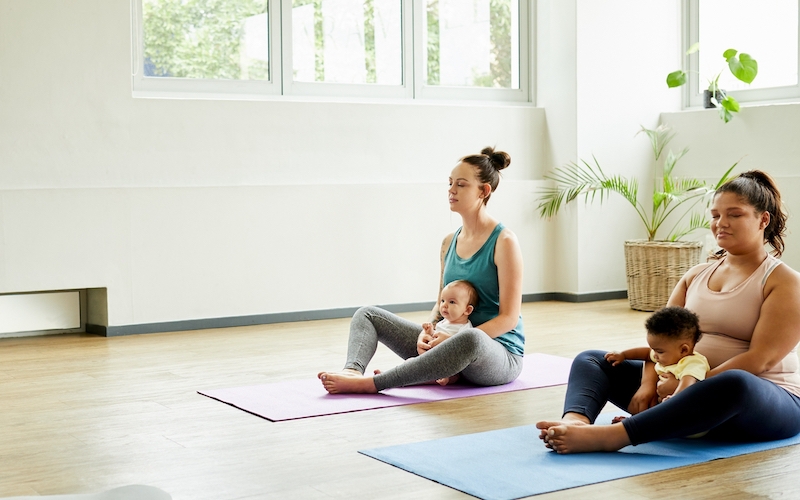Source: Australasian Society of Lifestyle Medicine (ASLM)
The postpartum period is the ideal time for health care professionals to recommend and educate women on evidence-based lifestyle interventions including exercise. The short-term benefits of postpartum exercise include improved mood, promotion of weight loss and maintenance cardiorespiratory fitness1. The long-term benefits are well demonstrated for both women and their children including the reduction in postpartum depression and anxiety, weight management, reduction in chronic cardio-metabolic disease, reduction in breast cancer risk and modelling health behaviours for families2,3,4. Incorporating evidence-based exercise prescription into the postpartum period is important for both supporting lifelong healthy lifestyles and public health benefit2,4.
Many women never return to pre-pregnancy physical activity levels4. Data from the Australian Longitudinal Study on Women’s Health shows a sharp decline in physical activity three years postpartum5. The most common barriers cited are lack of time, fatigue and depressive symptoms4. Other barriers include physical discomfort, parenting duties, lack of partner support, social isolation, financial concerns, neighbourhood safety, weather and lack of prioritizing health over competing responsibilities1.
General practitioners are in the ideal position to educate and prescribe exercise in the postpartum period6. Most new mothers will attend a GP with their baby multiple times in the first year. Postpartum mothers should attend a dedicated appointment in the first six weeks postpartum. Unfortunately many women do not make separate medical appointments to discuss and prioritize their health. Studies demonstrate the majority of new mothers will access social media for their postpartum health advice7 (concerning as it is without evidence-based regulation). The common belief among new mothers is that women need to be cleared to exercise at six weeks postpartum, however it is more detailed and complicated than this2.
It is difficult to locate clear postpartum exercise guidelines and often these recommendations are entwined with pregnancy guidelines1. Depending on the mode of delivery and whether there were any complications, gentle exercise can often resume sooner than six weeks postpartum2. This includes low intensity physical activity including walking, pelvic floor and abdominal muscle exercises1,2. The most recent guidelines published by the American College of Obstetrics and Gynecology in 20202 suggests:
1) Pelvic floor exercises can be initiated in the immediate post-partum period.
2) Abdominal strengthening exercise can begin soon after birth – these must be specifically drawing in exercises (transversus abominus activation). This has been shown to decrease the incidence of diastasis recti abdominus and decrease the inter-rectus distance.
3) Return to regular aerobic exercise improves cardiovascular fitness without affecting milk production, composition or infant growth.
If recovery post birth is progressing well, women are often encouraged to begin to progress from low intensity physical activity to more aerobic dynamic exercise at six weeks post vaginal birth and eight weeks post Caesarean section. At this stage post partum, women are recommended to following the Australian Guidelines for Exercise11:
1) Be active on most, preferably all, days every week.
2) Accumulate 150 to 300 minutes (2 ½ to 5 hours) of moderate intensity physical activity or 75 to 150 minutes (1 ¼ to 2 ½ hours) of vigorous intensity physical activity, or an equivalent combination of both moderate and vigorous activities each week.
3) Do muscle strengthening activities on at least 2 days each week.
There is ongoing confusion surrounding resumption of more aerobic and dynamic exercise on the pelvic floor. A 2021 published review8 indicates there are many ongoing knowledge gaps that need to be filled to understand the full effects of strenuous and non-strenuous activities on pelvic floor health. Referring to our women’s specialist physiotherapists andexercise physiology colleagues can assist with this assessment and management.
It is well documented that general practitioners need to improve their knowledge surrounding exercise prescription in general9,10. Our exercise prescriptions need to be specific formulations as if we were prescribing medications10. Many GPs feeling they lack the time and resources to provide this care in general, before considering specific patient populations such as postpartum women6. We need clear and accessible exercise guidelines, which will allow GPs to up skill and opportunistically target health interventions for this group4,6. Exercise prescription needs to be an essential skill in primary care and with our interest in lifestyle medicine we need to be at the forefront of this change. We have to educate ourselves and our colleagues and link in with our community services to support healthy lifestyle changes in postpartum women.
- Evenson KR, Mottola MF, Owe KM, Rousham EK, Brown WJ. Summary of international guidelines for physical activity after pregnancy. Obstet Gynecol Surv. 2014;69(7):407-414.
- Physical Activity and Exercise During Pregnancy and the Postpartum Period: ACOG Committee Opinion, Number 804. Obstet Gynecol. 2020;135(4):e178-e188.
- Dipietro L, Evenson KR, Bloodgood B, et al. Benefits of Physical Activity during Pregnancy and Postpartum: An Umbrella Review. Med Sci Sports Exerc. 2019;51(6):1292-1302. doi:10.1249/MSS.0000000000001941
- Borodulin K, Evenson KR, Herring AH. Physical activity patterns during pregnancy through postpartum. BMC Womens Health. 2009;9:32. Published 2009 Nov 19.
- Brown WJ, Heesch KC, Miller YD. Life events and changing physical activity patterns in women at different life stages. Ann Behav Med. 2009;37(3):294-305.
- Dorney E, Mazza D, Black KI. Interconception care. Aust J Gen Pract. 2020;49(6):317-322. doi:10.31128/AJGP-02-20-5242
- Guerra-Reyes L, Christie VM, Prabhakar A, Harris AL, Siek KA. Postpartum Health Information Seeking Using Mobile Phones: Experiences of Low-Income Mothers. Matern Child Health J. 2016;20(Suppl 1):13-21.
- Bø K, Nygaard IE. Is Physical Activity Good or Bad for the Female Pelvic Floor? A Narrative Review. Sports Med. 2020;50(3):471-484.
- Orchard JW. Prescribing and dosing exercise in primary care. Aust J Gen Pract. 2020;49(4):182-186.
- Nunan D. Doctors should be able to prescribe exercise like a drug. BMJ. 2016;353:i2468. Published 2016 May 5.
- Australia’s Physical Activity and Sedentary Behaviour Guidelines, Department of Health, April 2019.
